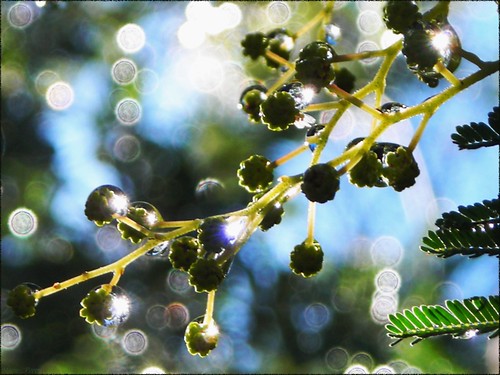Mimosa Glow
Early evening yesterday, I stepped into the drugstore to check my mail, and swept by the $19.99 shelf to find the tall frosted JLo Glow awaiting redemption from its place of non-glory. I thought I’d snatch it as a gift for my friend Tina, who loves spraying it on her hair and clothes (and it always makes her smell like she just washed her hair when she does). And right than and there, I decided to give it another try.
When Glow came out, I dismissed it as too sharp, too synthetic and too soapy to my taste. While this remains true for the first few minutes, I became pleasantly surprised when trying it on my skin for the first time in 8 years. In a world that sees a rapid life cycle for celebrity scents, JLo’s Glow is probably considered a classic by now, rivaled only by Sarah Jessica Parker Lovely.
What awaited me after the initial rash of synthetic orange blossom was something I did not expect. Although familiar, it took me a few minutes to figure it out… Provence! Shimmering mimosas, honeycombs and good old French milled soap. And a little bit of freesia too, which gives it just a touch of peppery greenness. And than a sweetness crept in, vanilla against mimosa, and I was in heaven for a few hours. By bedtime most of what I could smell was musk though, and that was the song I woke up to the next morning.
If Narcisso Rodriguez’s dry down resembles laundry detergent musk, Glow resembles whatever musk they like to put in milled soaps to keep your skin fragrantly “clean” for hours after washing. In that regard, the scent really is true to what it always claimed to be, starting from the ad copy, frosted glass that is reminiscent of a shower cell’s sliding doors and shaped like a yuppie shampoo bottle, to the image of Jennifer Lopez herself scrubbing all the ghetto-dirt from her perfectly carved abs and curves.
Rose with Jade Stem
 Getting back from shipping packages at the post office today, I was back at the lobby checking my own mail, which had a package, a few bills, and as usual - a delivery attempt notice from UPS, which could only mean one thing: I missed the courier guy by just a few minutes, as usual... And than the unheard of happened: I found the package waiting for me patiently right at my doorstep!
Getting back from shipping packages at the post office today, I was back at the lobby checking my own mail, which had a package, a few bills, and as usual - a delivery attempt notice from UPS, which could only mean one thing: I missed the courier guy by just a few minutes, as usual... And than the unheard of happened: I found the package waiting for me patiently right at my doorstep!This is unprecedented. It never, ever, EVER happens. But that was not where the good surprises ended today. This was a flacon of Patou's 1000 in parfum concentration I ordered off eBay last week. As it turns out, even though it was wrapped with cellophane and the bottle completely sealed, it was a vintage. In any case, it is at least old enough to exist before the IFRA regulations kicked in, with the requirement for a long list of allergens, and most importantly the oakmoss, which is now gradually being eliminated altogether from such Chyprish beauties!
1000 was better than I even remembered it. Releasing the stopper from the sealing film, I noticed it was covered but what looked like crystals (from the film perhaps?). Dipping the jade applicator in the precious jus (some of which evaporated) and applying it onto my skin was a magical moment. Off the jade glass rod, a rose emerged, with thorns and crushed leaves. Moss, amber, spice and a hint of tea-like osmanthus swirling around it like little green fairies.
1000 has the rich vintage air to it of a full-bodied, grown up perfume. It's not as dry and medicinal as I remember it. It certainly has the "old fashioned Chypre" feel to it with a tad of a soapiness (that seems to be the trademark of the 70's - 1000 was released in 1972 and was created by Msr. Jean Kerléo, who now runs the Osmotheque). And the rose really blooms and grows on the skin, a dark rose with its roots deep in patchouli, oakmoss, musk and a hint of ambery labdanum, and an even tinier hint of immortelle absolute. I'm in heaven.

Feuilles de Tabac - Review + Weekly Giveaway

Cigar Photography - Smoke 'Em if You Got 'Em - Phoenix Arizona, originally uploaded by ACME-Nollmeyer.
Feuilles de Tabac is one of those strange scents that I love yet have a difficult time writing about. I’ve been smitten with it ever since I came across it, sometime in 2003 after meeting with a perfumista client who kindly bombarded me with tens of samples from European niche perfumeries. I immediately fell for it, and when the vial ran out, begged my friend who lived in London to get out of her merry ways and fetch me a bottle.
Whatever it was that caught me in the Feuilles de Tabac trap, I can’t describe. It was the sense of familiarity in it that was intriguing to me. Something that happened to me before with Habanita (which reminded me of my grandfather’s Old Spice). But Feuilles de Tabac had something else, and was certainly more dry at first, and later on became sweeter, though not nearly as sweet as Old Spice.
Feuilles de Tabac dances between astringent and woody finesse and rustic herbal medicine.
The opening is dry, a little medicinal even, with the cascarilla bark dominating. Cascarilla is a bark used for flavouring tobacco, and has a scent that is both woody, musky and a little spicy-warm. There are also citrus and coniferous notes, though no particular one stands out, and allspice (pimento), a spice that has a dry-woody character. The other important note is sage, which is bitter and astringent at first, and than becomes velvety and warm, especially with the slight touch of rose at the heart.
Dry tobacco and vetiver peak in, but quickly, Feuilles de Tabac is cured into a very warm and sweet concoction, similar to pipe tobacco, with the tonka bean giving it a significant soft sweetness, as well as an amber accord with a muted labdanum. Only patchouli saves it from becoming powdery, adding a bold, animalic undertone and depth.
Feuilles de Tabac exudes such confidence that wearing it is akin to gulping some bravery potion, or just having a courageous powerful man on your side (unless you happen to be one).
It's interesting to compare sometimes notes from time past with the current impression of the same scent. In 2005, I described it as follows: "What starts as a medicinal, somewhat harsh drink – reminiscent of Absinthe – extremely masculine and sharp-edged – dries down to a seductive earthy sweetness. Warm, enveloping and sophisticated, Feuilles de Tabac is the emblem of what leathery-tobacco scents should be: Daring, sensitive, and seductive in a reassuring confident manner". Cascarilla has a certain liquor-like aroma to it; and sage is very similar to artemisia (absinthe). Perhaps this is where the courage comes from...
Top notes: Citrus notes, Coniferous notes, Cascarilla, Allspice
Heart notes: Sage, Rose, Vetiver
Base notes: Tobacco, Tonka Bean, Patchouli, Amber
*Weekly giveaway: Post a comment and win a 5ml decant of Feuilles de Tabac.*
Japanese Agarwood - Review + Giveaway

Allan Gardens: Tropical Paradise in the Middle of the Winter, originally uploaded by Canadian Pacific.
Japanese aesthetic is generally simple, elegant and clean (including some of the woods grown in Japan and used for incense as well – such as the watery hinoki and the dry hiba wood, not to mention the medicinal, clear borneol or camphor used in incense and body powders).
But when it comes to agarwood, the Japanese admire the dark and sometimes dirty and animalic agarwood. Agarwood incense is called jin-koh, and is the most prized over any other woods and is used in the koh-doh ceremony (translates to “the way of incense”). In particular – a variety of agarwood called kyara, which produces the darkest, most resinous, sweet and smoldering smoke, which seems to penetrate to the deepest parts of the soul and is so powerful it instantly brings the mind into a harmonious and meditative state.
Expect none of these effects from Japanese Agarwood oil roll-on. This interpretation of agarwood takes it all the way to the “clean wood” territory, leaving very little resemblence to agarwood of any kind. It is true that some agarwoods do have a clean smell, but they also always have something musty and complex about them, perhaps like a little mold attached to the continually moist bathing space.
Lisa Hoffman’s evening variation of the Japanese Agarwood scent is the most distinct of the four, but still, like I said, very transparent, pale and more watery than woody, with a somewhat tea-like, clean-musk dry down. According to the ad copy, “Japanese Agarwood was inspired by the lush, natural oils from the rainforest with subtle hints of Italian Bergamot, Spiced Ginger Accord, and Warm Amber. Within this complex, one also discovers mysterious earth nuances that are a delight to explore”.
It reminds me more of a greenhouse than a true rainforest; like the part of the nursery where they sell the tropical plants, and you can smell the water, fertilizers and moist compost and moss. There is nothing warm and ambery about it either. It’s a minimalist, clean, simple, aquatic woody, bordering on the sporty and definitely unisex if not a little on the masculine side when it dries down. The daytime version is even lighter, but perhaps also a little spicier, with the ginger note more pronounced.
Giveaway: Post a comment anywhere on SmellyBlog throughout the week (till next Friday) and enter to win Japanese Agarwood duo in the new packaging (designed by Lisa Hoffman's daughter) with the day time and the evening variations on Japanese Agarwood. I have tried both scents a couple of times, but both bottles are still full.
Coming next on SmellyBlog: A series about Agarwood and Sandalwood, including articles and reviews of other agarwood scents.


